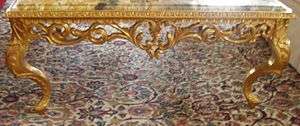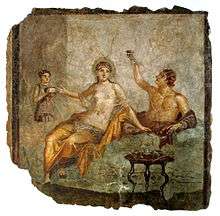Cabriole leg

A cabriole leg is one of (usually) four vertical supports of a piece of furniture shaped in two curves; the upper arc is convex, while lower is concave; the upper curve always bows outward, while the lower curve bows inward; with the axes of the two curves in the same plane. This design was used by the ancient Chinese and Greeks, but emerged in Europe in the very early 18th century, when it was incorporated into the more curvilinear styles produced in France, England and Holland.[1]

Herculaneum Italy in the first century
According to Bird, "nothing symbolises 18th century furniture more than the cabriole leg."[2] The cabriole design is often associated with bun or the "ball and claw" foot design. In England, this design was characteristic of Queen Anne and Chippendale furniture. In France, the cabriole leg is associated with the Louis XV period of furniture design.[3] The cabriole design appeared for the first time in the United States in the 18th century.[4] The basis of its original concept was emulated upon legs of certain four-footed mammals, especially ungulates. The etymology of this term specifically derives from the French word cabrioler, meaning to leap like a goat.[5]
History
Earliest forms of the cabriole leg were known in ancient Chinese and Greece. In the case of the ancient Chinese, this leg was most closely associated with the lacquered table. While the Chinese culture preserved historical continuity of use, Europeans lost this style prior to the Middle Ages. Finally in France, in the very early 18th century the cabriole leg style re-appeared, imitating a popular graphic scroll design found in French art about the year 1700; in France this design was part of the Rococo style. Quickly England was producing a version of the cabriole leg, which historically is called Queen Anne Style and is associated with the period 1712–1760.[6] (The reign of Queen Anne lasted from 1702 to 1712, but the Queen Anne furniture period is generally considered to continue until 1760, although imitations have, of course, endured to later periods.) The Queen Anne cabriole leg chair typically had a back with hoop design and a vase shaped splat; it also typically had a bun or pad foot. (An alternate design of a Queen Anne chair consisted of a Chinese style, which had flat cresting, vertical back edges and a leg that was also cabriole style.) A subsequent evolution of the cabriole leg in England occurred in about the year 1750 with the advent of Chippendale furniture design; while Chippendale chairs adopted the cabriole leg, the leg design became more delicate than those of the Queen Anne Style.[6]
American designs arose by the mid-18th century, imitating the English Queen Anne Style and borrowing elements from all three sub-periods of its development in England: Queen Anne period (1702–1714), George I period (1714–1727) and George II period (1727–1760). To demonstrate the central role of the cabriole leg in this period of American furniture, this period "has frequently been called the cabriole period, and this is no misnomer, since the cabriole leg found almost universal employment in most forms of furniture".[7] The American cabriole leg was strongly associated with the pad foot design.[6] Regional differences emerged in American cabriole leg styles by the mid to late 18th century; for example, the Commonwealth of Massachusetts style featured a very slender cabriole leg compared to other American locales.
Construction
In current times the cabriole leg continues in use and more modern manufacturing techniques are applied to form this complex shape.[5] In any case, the initial step is preparation of a template drawn on hardboard or cardboard. Structurally, the cabriole leg is weaker as the "S" shape is more accentuated or "bowed";[8] in any case the cabriole leg must be fashioned out of a solid piece of wood, rather than laminate.[9] Some of the initial rough turning is sometimes carried out using a lathe, but eventually a bandsaw is required due to the complex arc formations of the design.[5] The next steps include application of a spokeshave, rasp and scraper. The bottom of the leg may terminate in a bun, ball or "ball and claw" rendition; Queen Anne style furniture characteristically uses the bun foot (also called pad foot). The small brackets are constructed from a separate piece of wood and either affixed by dowels or screws.
Examples in notable collections
There are a number of cabriole leg pieces in important collections of historical antique furniture. In the noted collections of Henry Cavendish there is a set of "ten inlaid cabriole leg satinwood chairs with matching cabriole legged sofa" documented to have been acquired by Cavendish himself.[10] Another example is manifested in a cherry candlestand deriving from Gloucester with cabriole legs, described by the Essex Institute as produced between 1725 and 1750;[11] moreover, this specimen is notable for the early design of dovetailed attachment of the legs as opposed to dowelled attachment of later eras.
See also
- See also: Foot (furniture)
- Highboy
- Nursing chair
- Ormolu
References
- ↑ Encyclopædia Britannica – Cabriole Leg
- ↑ Bird, Lonnie. Taunton's Complete Illustrated Guide to Period Furniture Details. Taunton Press, 2003, pp. 24–26.
- ↑ French Accents: Fine Continental Antiques – Cabriole
- ↑ Greene, Jeffrey P. American Furniture of the 18th Century. Taunton Press, 1996.
- 1 2 3 Ernest Joyce and Alan Peters. Encyclopedia of Furniture Making. Sterling Publishing Company, Inc., 1987, pp. 208–221.
- 1 2 3 Joseph T. Butler, Kathleen Eagen Johnson, and Ray Skibinski. Field Guide to American Antique Furniture: A Unique Visual System for Identifying the Style of Virtually Any Piece of American Antique Furniture. Macmillan, 1986, pp. 28–43.
- ↑ Richard Townley, Haines Halsey, and Charles Over Cornelius. A Handbook of the American Wing Opening Exhibition. The Museum, 1924, p. 106.
- ↑ "Woodworking plans: How to build a cabriole leg". Woodzone.com, 2007.
- ↑ Lowe, Philip C. "Cabriole Legs: Hand-shaped, without a lathe". Fine Woodworking #42.
- ↑ "Cavendish", Russell K. McCormmach and Christa Jungnickel, ISBN 0-87169-220-1
- ↑ Essex Institute. "Essex Institute Historical Collections". Essex Press, 2003, p. 101.